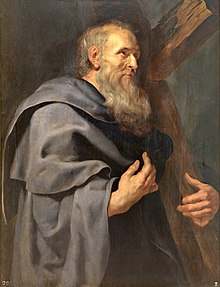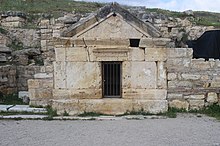| Saint Philip the Apostle | |
|---|---|
 St. Philip, by Peter Paul Rubens, from his Twelve Apostles series (c. 1611), at the Museo del Prado, Madrid St. Philip, by Peter Paul Rubens, from his Twelve Apostles series (c. 1611), at the Museo del Prado, Madrid | |
| Apostle and Martyr | |
| Born | 1st century after Christ Bethsaida, Galilee, Roman Empire |
| Died | 80 after Christ Hierapolis, Asia, Roman Empire |
| Venerated in | All Christian denominations that venerate saints |
| Canonized | Pre-congregation |
| Major shrine | relics in Basilica Santi Apostoli, Rome |
| Feast | As Philip and James, Apostles, in the Roman Rite and in Protestant commemorations:
14 November and 30 June: Eastern Orthodox Church (Translation of relics on 30 June) 17 November: Armenian 18 November: Coptic |
| Attributes | Red Martyr, elderly, bearded man, holding a basket of loaves and a Tau cross |
| Patronage | Cape Verde; Hatters; Pastry chefs; San Felipe Pueblo; Uruguay |
Philip the Apostle (Greek: Φίλιππος; Aramaic: ܦܝܠܝܦܘܣ; Coptic: ⲫⲓⲗⲓⲡⲡⲟⲥ, Philippos) was one of the Twelve Apostles of Jesus according to the New Testament. Later Christian traditions describe Philip as the apostle who preached in Greece, Syria, and Asia-Minor.
In the Roman Rite, the feast day of Philip, along with that of James the Less, is traditionally observed on 1 May, the anniversary of the dedication of the church dedicated to them in Rome (now called the Church of the Twelve Apostles). In the short-lived calendar reform of 1960, it was transferred to 11 May, but since 1969 it has been assigned to 3 May. The Eastern Orthodox Church celebrates Philip's feast day on 14 November.

New Testament
All three Synoptic Gospels and the Book of Acts list Philip as one of the apostles; he is always listed on the fifth place. The Gospel of John recounts Philip's calling as a disciple of Jesus. Philip is described as a disciple from the city of Bethsaida, and the evangelist connects him with Andrew and Peter, who were from the same town. He also was among those surrounding John the Baptist when the latter first pointed out Jesus as the Lamb of God. It was Philip who first introduced Nathanael (sometimes identified with Bartholomew) to Jesus. According to Butler, Philip was among those attending the wedding at Cana.
Of the four Gospels, Philip figures most prominently in the Gospel of John. Jesus tests Philip (John 6:6) when he asks him how to feed the 5,000 people. Later he appears as a link to the Greek community. Philip bore a Greek name, could likely speak Greek, and may have been known to the Greek pilgrims in Jerusalem. He advises Andrew that certain Greeks wish to meet Jesus, and together they inform Jesus of this (John 12:21). During the Last Supper, when Philip asked Jesus to show them the Father, he provides Jesus the opportunity to teach his disciples about the unity of the Father and the Son.
Distinct from Philip the Evangelist
Philip the Apostle should not be confused with Philip the Evangelist, who was appointed with Stephen and five others to oversee charitable distributions (Acts 6:5).
Apocryphal accounts
Nag Hammadi texts
One of the Gnostic codices discovered in the Nag Hammadi library in 1945 bears Philip's name in its title, on the bottom line. An early extra-biblical story about St. Philip is preserved in the apocryphal Letter from Peter to Philip, also one of the texts in the Nag Hammadi Library, and dated to the end of the 2nd century or early 3rd. This text begins with a letter from St. Peter to St. Philip, asking him to rejoin the other apostles who had gathered at the Mount of Olives. Fred Lapham believes that this letter indicates an early tradition that "at some point between the Resurrection of Jesus and the final parting of his risen presence from the disciples, Philip had undertaken a sole missionary enterprise, and was, for some reason, reluctant to return to the rest of the Apostles."
Acts: miracles and martyrdom
Later stories about Philip's life can be found in the anonymous Acts of Philip, probably written by a contemporary of Eusebius. This non-canonical book recounts the preaching and miracles of Philip. According to these accounts, following the resurrection of Jesus, Philip was sent with his sister Mariamne and Bartholomew to preach in Greece, Phrygia, and Syria. Included in the Acts of Philip is an appendix, entitled "Of the Journey of Philip the Apostle: From the Fifteenth Act Until the End, and Among Them the Martyrdom." This appendix gives an embellished account of Philip's martyrdom in the city of Hierapolis. According to this account, through a miraculous healing and his preaching Philip converted the wife of the proconsul of the city. This enraged the proconsul, and he had Philip, Bartholomew, and Mariamne all tortured. Philip and Bartholomew were then crucified upside-down, and Philip preached from his cross. As a result of Philip's preaching the crowd released Bartholomew from his cross, but Philip insisted that they not release him, and Philip died on the cross. Philip is also said to have been martyred by beheading, rather than crucifixion, in the city of Hierapolis.

Relics
The relics of Philip the Apostle are currently found in the crypt of Basilica Santi Apostoli, Rome, as well as the Church of St. Philip the Apostle in Cheektowaga, New York.
Possible tomb location

In 2011, Italian archaeologist Francesco D'Andria claimed to have discovered the original tomb of Philip during excavations in ancient Hierapolis, close to the modern Turkish city of Denizli. The 1st-century tomb, found to be empty of relics, stood at the centre of the 4th- or 5th-century three-naved basilica, the Church of the Sepulchre, which was one of the focal points of an entire ancient pilgrimage hill complex dedicated to Philip. Ancient Greek prayers are carved into the walls of the tomb and church venerating Philip the Apostle, and a 6th-century bread stamp (signum pistoris [es]) shows Philip holding bread (John 6) with this specific three-naved church on his left side, and the previously identified nearby martyrion church to his right, removing all doubts about the basilica being the one to contain the original tomb of the apostle. The church built on his tomb and the martyrion church some 40 yards away were places of intense veneration for centuries: In Philip's Church of the Sepulchre the marble floors were worn down by thousands of people.
In 2012, Bartholomew, the patriarch of Constantinople and primate of the Orthodox church, celebrated the liturgy of St. Philip in the Church of the Sepulchre and in the martyrion church of the apostle.
Iconography
See also: Christian cross variants
Philip is commonly associated with the symbol of the Latin cross. Other symbols assigned to Philip include: the cross with the two loaves (because of his answer to the Lord in John 6:7), a basket filled with bread, a spear with the patriarchal cross, and a cross with a carpenter's square.

Veneration
Philip is remembered (with James) in the Church of England with a Festival on 1 May.
Eastern Orthodoxy
The Eastern Orthodox Church commemorates Philip on several days of the year.
- November 14: Primary Feast Day.
- June 30: Synaxis of the Twelve Apostles.
- July 31: Translation of Philip's Relics to Cyprus.
His feast day begins the Nativity Fast in the Eastern Orthodox Church, that is called Philip's Fast (or the Philippian Fast), the Fast is Eastern equivalent of Western Advent.
Patronage
Saint Philip is the patron saint of hatters.
See also
- Gospel of Philip
- List of biblical figures identified in extra-biblical sources
- Nordic cross flag
- Philip the Evangelist
- Saint Philip the Apostle, patron saint archive
Notes
- Philip is mentioned 11 times in the New King James Version of John's Gospel, and three times in each of the other Gospels
References
- Jn 1:43
- ^ "CATHOLIC ENCYCLOPEDIA: St. Philip the Apostle".
- Nicoll, W. R., Expositor's Greek Testament on John 12, accessed 10 June 2016
- Butler, Alban. "St. Philip, Apostle", The Lives or the Fathers, Martyrs and Other Principal Saints, Vol. V, 1864
- Drane, John (2010). Introducing the New Testament. Lion Books. p. 240. ISBN 9780745955049.
- Martha Lee Turner, The Gospel According to Philip: The Sources and Coherence of an Early Christian Collection, page 9 (E. J. Brill, 1996). ISBN 90-04-10443-7
- Translated in James M. Robinson, editor, The Nag Hammadi Library (New York: HarperCollins, 1990), pp. 431–437
- Fred Lapham, An Introduction to the New Testament Apocrypha (London: T & T Clark International, 2003), p. 78
- Craig A. Blaising, "Philip, Apostle" in The Encyclopedia of Early Christianity, ed. Everett Ferguson (New York: Garland Publishing, 1997).
- "Acts of Philip – especially Book 8". meta-religion.com. Retrieved 14 March 2007.
- Schaff, Philip (1885). "Ante-Nicene Fathers, Volume 8". Christian Classics Ethereal Library. Retrieved 14 March 2007.
- "Friday: Santi XII Apostoli", PNAC
- "Relic of St. Philip the Apostle". St. Philip the Apostle Parish. Retrieved 24 May 2022.
- ^ "Tomb of Apostle Philip Found". biblicalarchaeology.org. 16 August 2014. Retrieved 1 September 2015.
- John. "How I Discovered the Tomb of the Apostle Philip: Interview With Archaeologist Francesco D'Andria". Retrieved 12 April 2022.
- "The Calendar". The Church of England. Retrieved 27 March 2021.
- "Holy, All-Praised Apostle Philip". OCA. Archived from the original on 13 November 2024. Retrieved 26 November 2024.
- "Synaxis of the Holy, Glorious and All-Praised Twelve Apostles". OCA. Archived from the original on 30 June 2024. Retrieved 26 November 2024.
- "Orthodox Calendar: Old Style, July 31; New Style, August 13". OrthoChristian. Archived from the original on 26 November 2024. Retrieved 26 November 2024.
- "Рубрика "Рождественский пост" - Пять ступеней веры". azbyka.ru (in Russian). Retrieved 14 July 2022.
- "Advent and Nativity Fast". Vanderbilt University. Retrieved 14 July 2022.
- Grube, Madison. "St. Philip the Apostle and History". The Falcon's Flyer. Retrieved 14 May 2022.
External links
- Catholic Encyclopedia: Apostle article regarding the title "Apostle" from the Catholic Encyclopedia
- "Philip (1.)" . Encyclopædia Britannica. Vol. XVIII (9th ed.). 1885. p. 742.
- Catholic Forum: St. Philip
- Holy, All-Praised Apostle Philip Orthodox icon and synaxarion
| Catholic Church Titles | ||
|---|---|---|
| New creation | Bishop of Hierapolis 1st century |
Succeeded byPapias of Hierapolis |
| Twelve Apostles of Jesus | |
|---|---|
| Apostles | |
| Later | |
| Related | |

